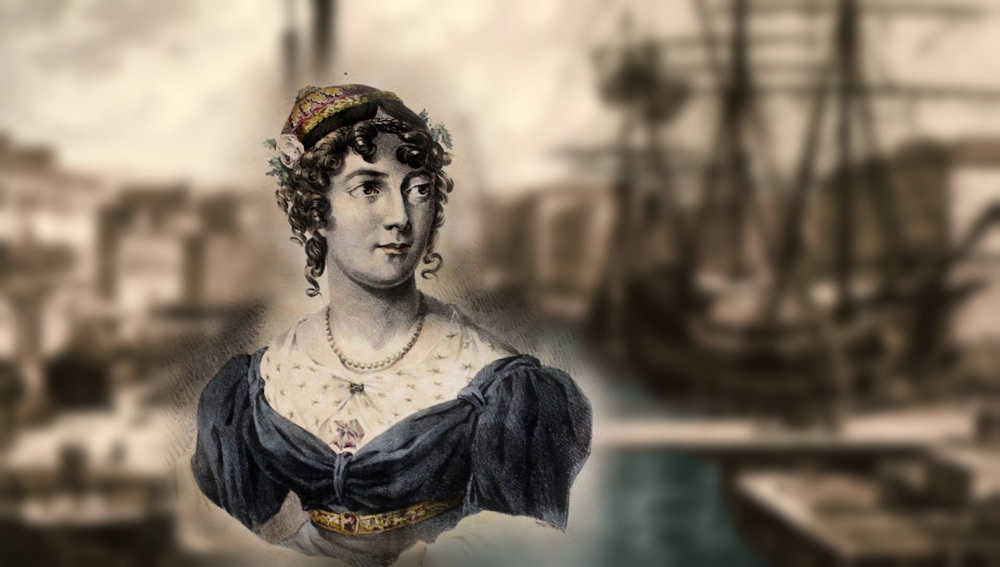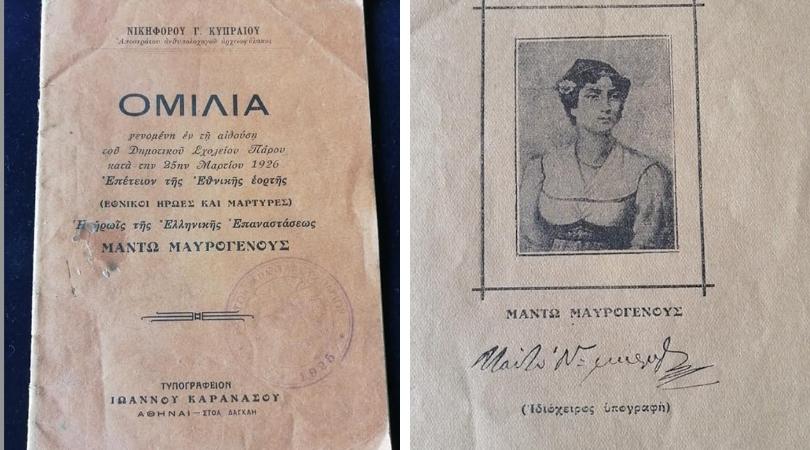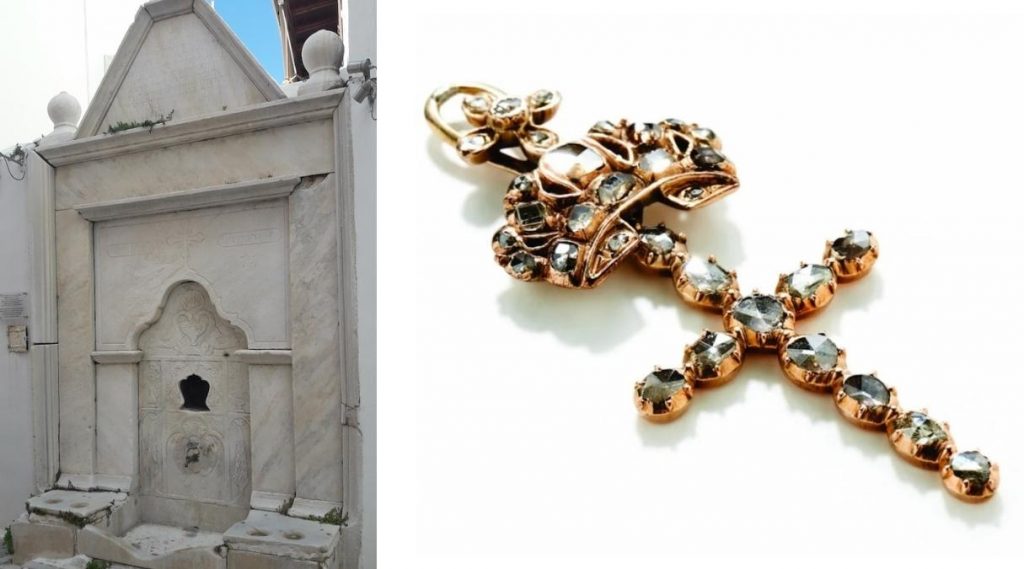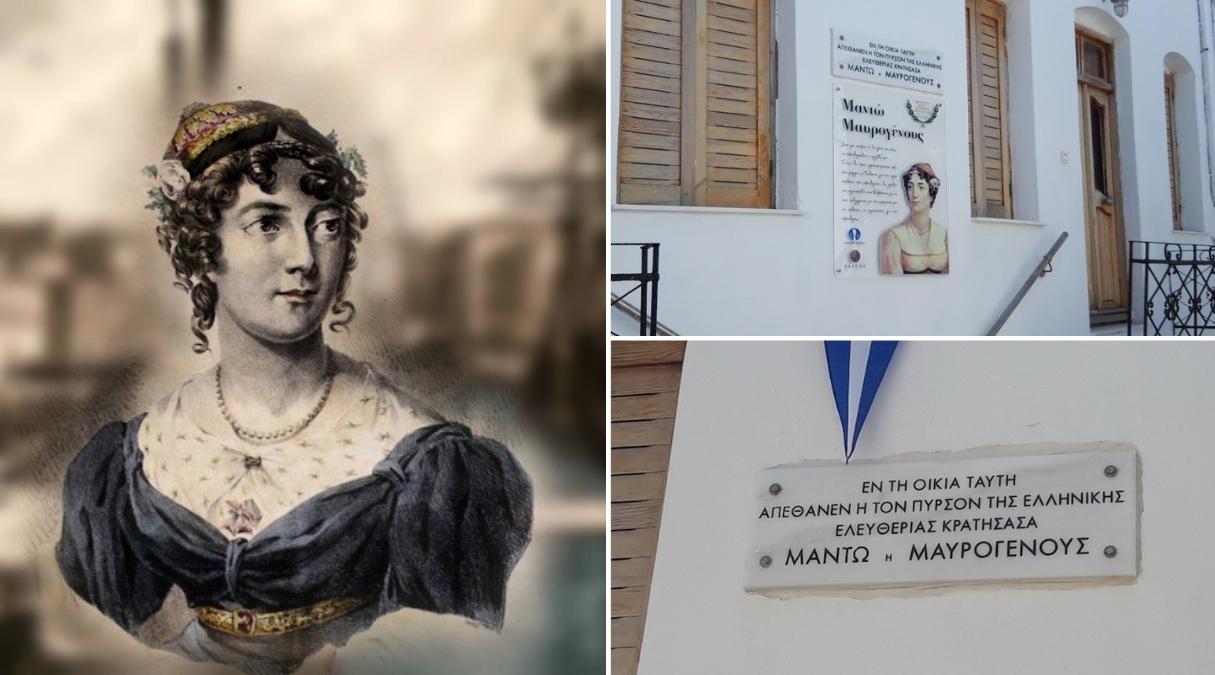By Panagiotis Dalatariof
Manto Mavrogenous was a dominant figure of the Greek Revolution of 1821. She devoted herself wholly to the ideals and the justnesses of the Freedom of the nation, selflessly offering her love for her country.
Her ancestors were born and lived in Paros. Her great-grandfather, Ioannis Mavrogenis, settled in Marmara of Paros and his son was Nikolaos Mavrogenis, Ruler of Moldovlachia, who built the three marble fountains located on the main street of Parikia. Ioanni’s other son, Demetrios, brought to life Petros Mavrogenis, father of Manto.
Manto was an educated, beautiful cosmopolitan, tall and imposing woman, who spoke French, Italian and Turkish, and was influenced by the values and ideas of the Enlightenment.
She visited Greece at the age of 19 and her immense love for her homeland came from her uncle Reverend Nikolaos Mavros. Thus, she allegedly made the decision to devote herself to the struggle for freedom by offering her entire fortune on the altar of the righteous of the nation.

The website “parianostpos.gr”, reports on Manto’s devotion to the fatherland and the struggle for freedom:
“With ships equipped at her own expense she pursued Algerians who ravaged the Cyclades, equipped two manned ships with which she pursued pirates who attacked Mykonos and other islands of the Cyclades. In October 1822, the Mykonians repulsed the Turks under her leadership. She also equipped and supplied 150 men to campaign in the Peloponnese and sent forces and financial support to Samos when the island was threatened by the Turks. She sent a force of 50 men to the Peloponnese who participated in the capture of Tripolitsa by the Greeks.
“She spent money for the relief of the soldiers and their families but also for the preparation of a campaign in northern Greece, with the support of many Philhellenes. She formed a fleet of six ships and infantry consisting of 16 groupswith fifty men each and took part in operations at Karystos in 1822. She financed the campaign of Chios, but failed to prevent the massacre of Chios. She reinforced Nikitaras with 50 men in the Battle of Dervenakia. When the Ottoman fleet appeared in the Cyclades, she financed the supplies and equipment of the 200 men who fought the enemy and provided shelter to two thousand people who had survived the first siege of Missolonghi. Her men participated in many other battles such as those of Pelion, Fthiotida, Livadia”.

Everything she had, movable and immovable property, money and jewelery she offered to the National Liberation Struggle.
It is estimated that 700,000 piastres, an amount incredible for those times, were spent by her for the Hellenic cause. In 1825, while her resources were depleted, she was forced to divest her family’s properties in the Cyclades islands.
After the murder of Kapodistrias (1831), survival problems were exacerbated, while relations with her family deteriorated. She was accused of squandering the large family property. She was then forced to address a letter to King Otto and explain her situation to him. She never received an answer.

She tasted the ungreatfulness of her homeland as when she applied for a pension as a retired fighter in front of a state official, she was asked: “and what did you do for your homeland?” and the proud Manto to the end, replied: “Nothing…”
The last years of her life, she spent them as a poor, forgotten and impoverished woman. In a state of destitution, she dwelt in Paros where some of her relatives lived. In July 1840, she contracted typhoid fever and died forgotten by all in Paros, the island of her ancestors in 1848. Her body passed through the central alleys of Parikia and ended at the Holy Church of Panagia Ekatontapyliani where the funeral service was performed.
Giannis Vasiliopoulos: “Manto did not stay with her cousins in Paros”
The president of Friends of the Municipal Library of Paros, Giannis Vasiliopoulos, spoke to the Greek Herald about the family that hosted Manto Mavrogenous in the last years of her life.
“The House today belongs to the Kritikos family. This house belonged to the Madibella family. When it hosted Manto it belonged to Margarita Madibella.
She was single then and later married a notator of Andros. Manto became their matron of honour. Manto, in Paros, had cousins but they didn’t host her.
The Madibella family, as a family of Paros, appears in 17th-century documents to be konsouli (official representative of state) of England. Great family, educated, who hosted Manto.

This house is one storey in Potamos area of Parikia. In the year 1986-1987, the owner of the house, Mrs Kritikos wanted to rent it due to tourism. So, she did some changes to the building without permission. The house was listed in 1987 under Melina Mercouri. She built a floor above, changing its facade. But she did not change the sign of the house.
When the house changed its appearance, people became very upset with the owner. “What are you doing? This house is important to our country,” they told her.
The house from then until now is preserved and belongs to the Kritikos family”.
TGH: This house was never used as a museum?
“No, alas, never! This family never stayed in. It was rented from 1980 onwards when tourism started picking up”.
TGH: So you tell us that such a historic house over the years was used as a simple house for accommodation?
“Yes, yes… Now I don’t know if it is currently inhabited. But it was used to meet tourist needs. Especially the upper floor that was then made. This is the story of this house.
It is a house from the 15th-16th centuries. Parikia has been inhabited for 5,000 years continuously. With the excavations that took place you see the prehistoric, the archaic, the classical and so on”.

TGH: The house where Manto Mavrogenous stayed, you told us is in the area “Potamos”, in the alley that leads to Panagia Ekatontapiliani. Right?
“Yes… Manto, when she died, was buried in Ekatontapyliani. In 1962, when Orlandos, that great professor of Archaeology, did the restoration, tried to find the tomb. He used as reference the story that she was buried there in the Lieutenant General’s uniform. However, as he reveals in his report, he found nothing.
Corres, a writer, says she was buried northwest of Ekatontapyliani. The name “Mavrogenous” was engraved on the tomb, but they found no insignia. Others said that her bones were taken to Mykonos to local people that belonged to her family. Now if her bones were in Paros we don’t know.
TGH: Are members from the Mavrogenous family living in Paros?
“Yes there are. Perhaps the Dimitrakopoulos are the continuation of the family”.
The rare 15-page book from Nikiphoros Kypraios ‘ speech about Manto Mavrogenous
At the Primary School of Paros on the 25th of March 1926 anniversary of the Greek Independence Day, Nikiforos Kypraios – retired officer- was invited to speak about the national heroes and witnesses of the revolution with extensive reference to the life of the heroine Manto Mavrogenous.
As a man of insight he had the providence that a small book of 15 pages should be printed containing the discourse he uttered on that day. So this speech has remained alive and will remain forever. Very likely, of course, it was printed by the association of “ALL PARIANS of EKATONTAPYLIANI” since it bears the stamp with their logo. This small in size and volume book is quite rare and this is because due to its simple binding it is easy for someone not to pay proper attention to it and easily go to the bin.
* Special thanks to Michael Roubanos for providing rare photographic material

